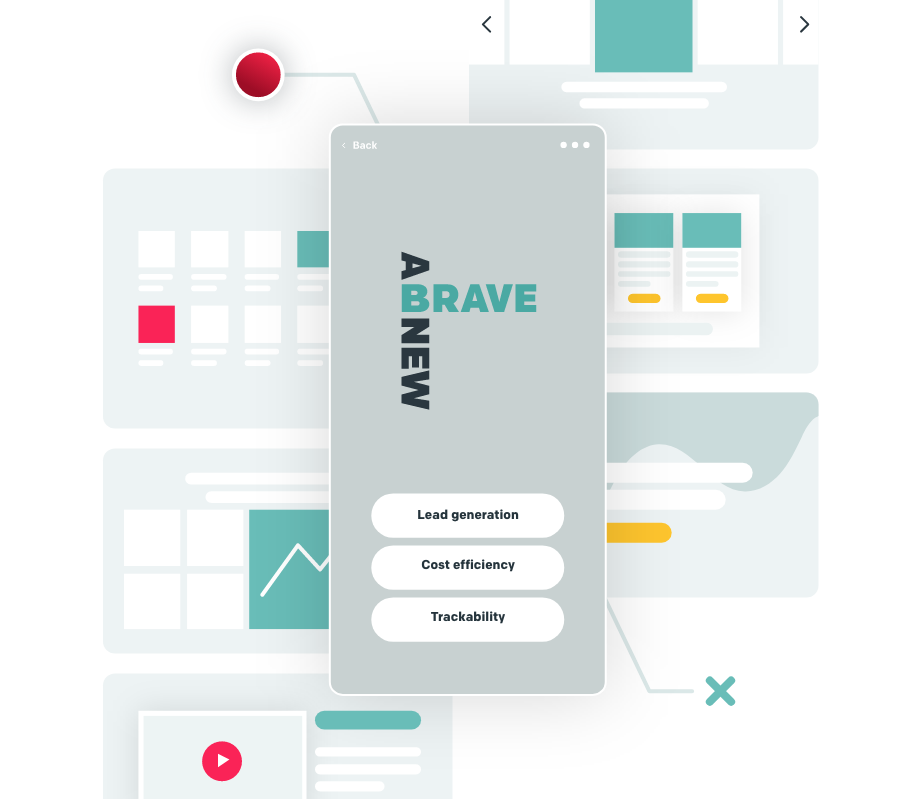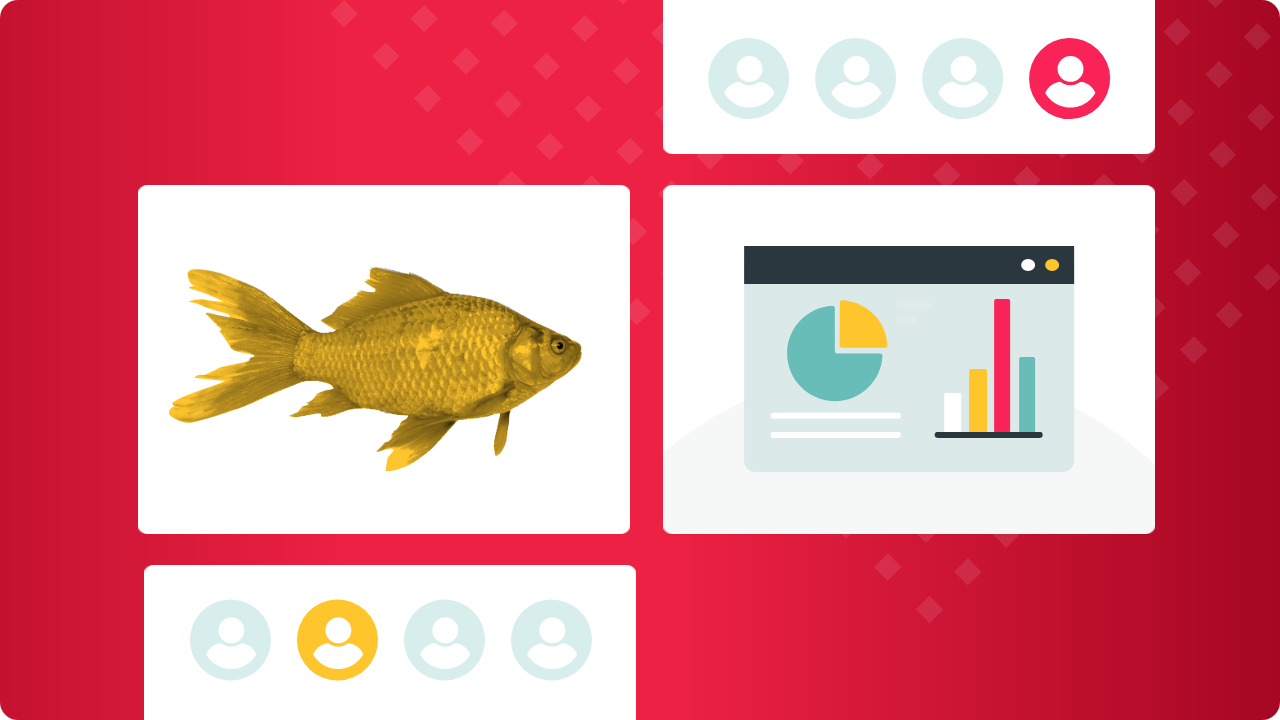Introduction
Okay, just hear us out
We know that the words “direct response marketing” evoke eye rolls and shudders out of many self-respecting marketers. According to prevailing wisdom, direct marketing is old-school. It’s gauche. It’s pushy. It’s…telemarketing. Ugh.
We understand. But we also have a confession to make: before founding A Brave New, we actually got our start working in direct response agencies. As we moved into the world of B2B marketing, we used to be a little embarrassed about our past.
But direct response marketing taught us some essential things that most marketing often glosses over — how to be tactical, disciplined, and laser-focused on actual results.
A Brave New is a B2B growth marketing agency, but we’ve got something up our sleeve: the core principles of direct response marketing. We’re going to share what they are, why they work, and how you can use them to make any marketing program more effective.

The core of direct response marketing is clear and direct communication.

Know your audience through data only
Direct response marketing views its audience through one lens and one lens only: data. Data reveals someone’s actual behaviors; including what actions have they taken in the past and what provoked them to take those actions.
In the world of direct response marketing, it doesn’t matter one bit what your audience aspires to do, or what they say they’re planning to do. It doesn’t matter whether they saw your content. All that matters is what they actually do, or have done.
Organizations that leverage customer behavior data to generate behavioral insights outperform peers by 85% in sales growth.

Measure only what matters
Impressions, website traffic, reach — the direct response marketer doesn’t care about these. Know what they do care about? How many sales were made. How many desired actions were taken.
Vanity metrics like social impressions, audience size, and number of subscribers can be more misleading than they are helpful when they’re used to measure the success of a program. They can make your marketing effort appear more successful than it really is — and that will ultimately hold you back. We do however believe these metrics can be used to guide optimization efforts for specific tactics.
“Any metric you can buy your way out of is probably not a useful metric to measure yourself by…the helpful metrics are the ones where cash isn’t the solution.” — Seth Godin

Build off what works
Direct marketers don’t recreate things just because. Instead, they figure out what tactics worked before and only tweak them if they have a reason to: to test a hypothesis for improvement or update copy to make it season-specific.
Why? Because the best predictor of what will work is what worked in the past. If a tactic didn’t perform well in the past, don’t do it again. And we’ll let you in on another little secret: people are not paying close attention to your marketing. They probably will not notice if you send an email that’s near-identical to the one you sent last year (or even last month.) Direct marketers take advantage of this by repeating a proven tactic until results start to fade.
“Herein lies the magic of the conversion rate: You just optimize what’s already there and thus create more profit from your existing customers and traffic.” — Neil Patel

Ask for one thing
Direct marketers stick ruthlessly to one message at a time and communicate it clearly. They let the audience know what they want them to do, tell them the consequences of inaction, and describe the benefits of action. It’s as simple as that.
It takes discipline to stick to a single call to action, because it seems like giving your audience different options will make it more likely that you’ll get a response. But in fact, multiple options tend to have a paralyzing effect. Direct marketers know that if they keep it simple, their audience is more likely to follow through with what they’re being asked to do.
“Emails with a single CTA increased clicks by 371% and sales by 1617%” (Wordstream)

Ask again (and again)
Direct marketers will tell you to keep repeating your call to action until it starts to feel slightly awkward. This gets easier when you accept the fact that people aren’t paying close attention and likely didn’t even notice the first time you said it. Instead, they’re scanning your content quickly to determine whether it’s relevant enough to them to spend a few extra seconds of their time on.
Think about how you interact with the proliferation of content that passes in front of you each day. How do you decide what to engage with and what to screen out?
When in doubt, remember the marketing rule of 7: a prospect needs to “hear” your message at least 7 times before they’ll take action to buy that product or service. And many people say that this “business school classic” is now closer to the rule of 77 with the onslaught of content people are exposed to every day.
“Consumer response to an ad is maximized when they’ve been exposed to it 10 times” (Journal of Advertising)
Opposites attract (your audience)
Okay, okay, okay. Are you confused yet?
If you’re familiar with the principles of inbound marketing, the rules of direct response marketing sound like they’re the exact opposite of a pure inbound or content-first methodology.
Inbound marketing is about helping your audience—winning hearts and minds by being radically helpful with perfectly timed education. It aims to build trust and connection between your brand and your audience. Direct response doesn’t do any of those things. It’s about asking the audience to do something, telling them the consequences if they don’t act and the rewards if they do. And then asking again.

So exactly why should you embrace the principles of direct marketing? This might seem like an either/or decision. Here's why it's not:

We love inbound marketing, and we think it works
But pure inbound tactics alone aren’t as effective at provoking action as they are at creating engagement and building trust. Our experience with direct response marketing has taught us that inbound works better when there’s a balance between education and directly asking people to do what we want them to do.
Pure inbound marketing is all about attracting your audience by being helpful and then waiting for them to take action. If you’ve done your job well, they may eventually take that action but you don’t have the power to predict when that will happen.

Direct marketing makes the first move
It’s about spurring the audience into action. And our clients hire us to get results, not to be inbound marketing purists. That’s why we use all the tools available to us.
By incorporating the discipline of direct response in the right places, you can get better results from your inbound marketing program. That’s because these tactics tap into some essential truths about human behavior.
Here's a side-by-side comparison


What direct response gets right about human behavior
Here's a side-by-side comparison
- Subject line isn’t “you” focused
- Preview doesn’t tell specifically what to do
- Intro is education focused rather than immediately capturing attention and telling someone why information is relevant
- Data could be more specific and establish a clear connection between the data and the needs of the audience
- Effectiveness is hurt because CTA is saved til the end of the email and not strongly connected as the core idea throughout the email
- Subject line is “you” focused, tells reader to do something.
- Direct preview so that the reader isn’t surprised when they read email
- Intro immediately captures attention and communicates consequences of inaction, then shifts towards call to action
- Additional content uses deeper information to reinforce
- Final CTA keeps up the theme while adding personal touch
Do we believe that oft-quoted and contested aphorism that the attention span of the average human being has shrunk lower than a goldfish’s?
Well, we don’t market to an audience of goldfish, so we’d consider that a vanity metric.
Here’s the thing: nobody is competing for the attention of goldfish. Everybody is competing for your audience’s attention.


"306.4 billion emails were sent and received each day in 2020 (statista)"

"Most Americans are exposed to around 4,000 to 10,000 ads each day (Forbes)"

On average, Amercians spend 13 hours and 35 minutes consuming media each day (eMarketer)"
We’re not saying that your audience is lazy or easily distracted. We’re saying that they’re just like almost everyone else—living in a world cluttered with content and contradictory messages. They’re busy cleaning out their inbox, scrolling through their feed, and making split-second decisions about what’s important and what isn’t.
How do they make those split-second decisions? Well, to put it in zoological terms, it’s the lizard brain that often makes the call. People want to impress their bosses and avoid the negative consequences of making a bad decision at work, but they aren’t often persuaded by logical arguments alone. They’re motivated by the desire for achievement, safety, belonging, competence, power, and autonomy. Or, they’re reacting to fear, envy, and jealousy. The best brands tap into these primal emotions and fulfill the need that they create.
Most of the time, an audience won’t be interested in what you’re offering — until they urgently need it. Then they’re highly motivated and spurred into action by a strong emotion. The key is to keep sending your message until it catches them at the right moment.
Direct response marketing doesn’t try to change human behavior. It understands and accepts human behavior as it is. Then, it responds in the most effective way to get action: through clear communication, repetition, and singular focus.
How to incorporate direct response tactics into bound marketing
To start bringing direct response tactics into your marketing, use a SMART approach (specific, measurable, actionable, relevant, time-bound):
Specific
Each piece of marketing collateral should focus on asking the audience to do one thing. Excess details cause confusion and too many choices will sidetrack or paralyze your audience.
Relevant
Speak to the needs of your audience, and keep your message benefit-oriented in a way that appeals to their emotions. What’s in it for them?
Measurable
Start by deciding how success will be measured. Define what “results” look like.
Time-bound
Another way to appeal to your audience’s emotions is to create a sense of urgency by giving them a deadline to respond by. If they don’t feel the need to act now, they probably never will.
Actionable
Your message should give your audience a good reason to take action immediately, not put it off and forget about it. Remember that their decision will likely happen in a split second.
In our experience, the most powerful marketing combines tactics of inbound marketing and direct response. Here are some of the places we’ve found direct marketing principles to be the most effective:
Conversion emails
At the end of nuture pathways
Landing pages
Ads
Here's an example of the difference
between a purely educational landing page and one that uses direct marketing principles:
- This copy is true but doesn’t direct someone to act
- Intro is education focused rather than immediately capturing attention and telling someone why information is relevant
- This headline is weaker because it removes the you focused language, puts the focus on A Brave New not the reader and doesn’t push them to read
- This sentence is informational but should compel someone to action
- Note that having no CTA down here reduces conversion rates
- Use of the word “free” to generate interest
- Headline focused on benefits
- CTA tells user exactly what to do
- “You” and “benefits” focused language
- Specific listing of benefits
- Repeated calls to action
Every time you leave your audience hanging or unsure what to do next, you run the risk of losing them. They may remember to come back to you later—or they may not. So make it a no-brainer for them to take action immediately.
By taking a direct, disciplined, and laser-focused approach at the right moments, you can cut through the noise and make it radically easy for your audience to respond. You don’t have to be awkward or pushy. Just meet the audience where they are, design your communication with their challenges in mind, and provide them with a clear path forward. You’ll see the results. That’s why no inbound marketing program is complete without a little bit of direct marketing.
And when in doubt, repeat your CTA.
REACH OUT
Take the first step toward a lasting impression
Interested in learning more? We’d love the opportunity to connect. Let’s have a conversation about how ABN can support you in both building a brand that lasts and exceeding your business goals.

